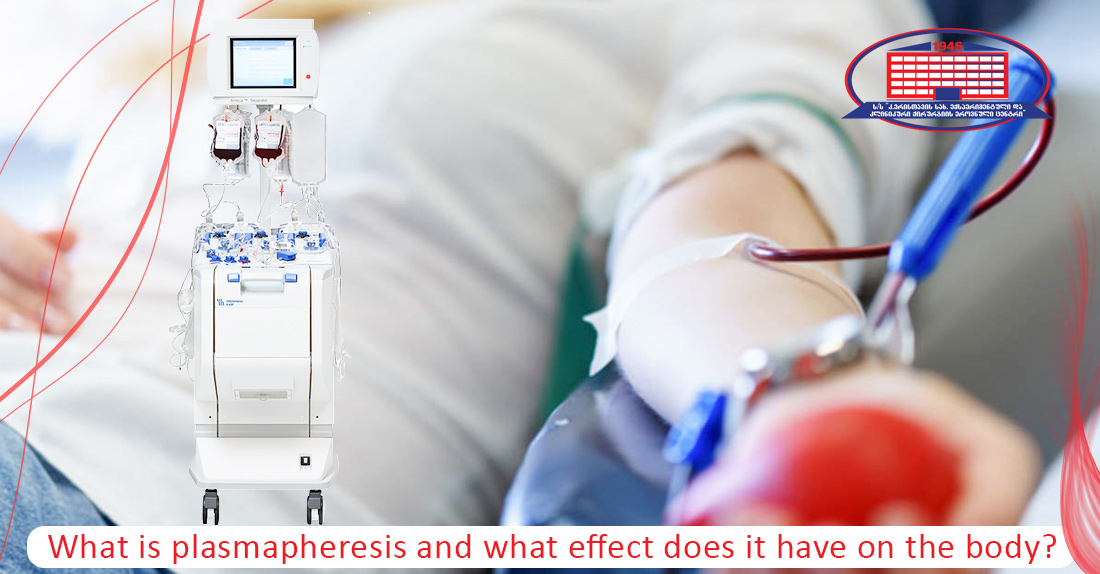
How is the aforesaid procedure conducted at National Center of Surgery?
In the article, you will be informed about the following:
What is plasmapheresis?
Plasmapheresis is an extracorporeal (outside the body) method of therapy, during which plasma is separated from the body.
What is it used for?
Plasmapheresis aims to remove toxic and metabolic waste causing various diseases from plasma and to detoxify the body. During the procedure following harmful substance are discharged alongside plasma:
- Toxins;
- Harmful proteins;
- Hormones;
- Antigens;
- Antibodies;
- "Bad" lipoproteins;
- Infectious agents;
- Dead cells of the immune system;
- Inflammatory mediators;
- High level of fibrinogen;
- Tissue and cell breakdown products.
In case of which diseases is it conducted?
Plasmapheresis is conducted in the following diseases:
- Cardiovascular diseases (arterial hypertension, ischemic heart disease, atherosclerosis, viral myocarditis);
- Skin diseases (psoriasis, eczema, atopic dermatitis, Lyell's syndrome);
- Allergic diseases (bronchial asthma, hives);
- Autoimmune diseases (aids, vasculitis, myasthenia gravis);
- Endocrine disorders (diabetes and thyroid disorders);
- Gastrointestinal diseases (hepatitis, cholecystitis, pancreatitis, ulcerative colitis, Crohn's disease);
- Obstetric gynecological disorders (premenstrual syndrome, chronic inflammatory diseases, infertility, prophylaxis in Rh incompatibility, menopause, preparation for extracorporeal fertilization, toxicosis during pregnancy);
- Toxicologic diseases (alcoholism, drug addiction, substance dependency);
- Rheumatic disorders (rheumatoid arthritis, systemic lupus erythematosus);
- Urologic diseases (chronic urethritis, prostatitis);
- Chronic fatigue syndrome.
Diseases that require plasmapheresis:
- Paraproteinemic hemoblastosis;
- Thrombotic thrombocytopenic purpura;
- Septic conditions;
- Systemic capillaritis;
- Multiple Sclerosis (in ineffective glucocorticoid treatment);
- Polyradiculoneuritis;
- Collagen disorders.
What device is used at National Center of Surgery and what are the advantages of it?
In National Center of Surgery plasmapheresis is conducted using Fresenius Kabi’s latest device Fenwal Amicus Separator. The device is distinguished by the intelligent control system that makes the procedure easier to conduct and increases its' effectiveness.
Device form and technical structure are much more comfortable for the donor (low noise frequency, single needle, or double needle approach). Procedure time is shortened (less than 1 hour), individual control of anticoagulant delivery. After donor parameters are loaded, the device determines blood flow pace and necessary dose of anticoagulant. This is particularly important for patients who are sensitive to citrate (anticoagulant).
Safety is ensured by disposable kits that are sterilized using a special irradiation method. The intelligent control system enables the management of the whole procedure. In case of procedure disturbance or detection of inaccuracies, the device warns us with respective information, which allows us to promptly take measures.
Device construction and design fully satisfies the strictest international standards.
How is the foresaid manipulation conducted and how long does it last? Does the procedure cause discomfort?
Plasmapheresis is conducted in a comfortable environment for a patient. The duration is 30-40 minutes. The approach is one needle or double needle-based (double needle-based is relatively shorter). The procedure is conducted without interruptions. Plasma is removed and blood elements simultaneously flow back to the body.
Patient’s discomfort is minimal during the procedure (it might occur only during venipuncture and fixed hand position in plasmapheresis).
What positive effect does it have on the body?
- Plasmapheresis reduces the level of harmful substances circulating in plasma;
- Cleans blood and every tissue of the body;
- Improves blood supply to every organ and system by cleaning the blood and removing cholesterol plaques;
- Stimulates brain function;
- Normalizes heart function ensuing the resolve of stenocardiac attack;
- Improves hepatic, renal work ensuing prompt removal of waste and harmful substances;
- Strengthens immunity;
- Improves skin structure;
- Assists in weight loss.
Contraindications
There are absolute and relative contraindications of plasmapheresis.
Absolute are:
- Acute bleeding;
- Allergic reaction to components used in plasmapheresis;
- Severe brain injuries.
Relative contraindications are:
- Hypotonia;
- Visible anemia;
- Hypoproteinemia;
- Peripheral venous phlebitis;
- Alcoholic effect;
- Abstinence syndrome;
- Acute period of infectious diseases;
- Hemostatic disorders;
- Menstruation;
- Mental disorder.
How to prepare before the procedure?
It’s necessary to undergo clinical-laboratory tests before plasmapheresis. During the procedure, proteins necessary for the body are removed together with harmful substances, that’s why it's recommended to consume nourishing food for several days before the procedure, relax and eat light breakfast on the day of the procedure.
Following aren’t recommended after the plasmapheresis:
- Physical stress;
- Consumption of alcohol;
- Consumption of tobacco;
- Removal of dressing for 3 hours.
We should avoid cold temperature and contact with an individual affected by a virus.
Wish you health!
What are patients interested in
Low hemoglobin count
Qauestion:: My father is 72 years old and has a hemoglobin level – 63, I’m interested in how low and dangerous is this level?
Splenomegaly
Qauestion:: Hello, as a result of the strike, my left side i.e spleen started to hurt several months ago. It can be identified through contact and it hurts. Then the pain was relieved but started to hurt again a few days ago. Spleen is enlarged. What can be the cause of it? It started to hurt again after I caught a cold. It could be examined through contact. How can the spleen return to its normal size and what can I take?









